This post may contain affiliate links. Please read our disclosure policy.
Hot pot is more than just food—it’s a social event. In many Asian families, it’s how we gather around the table, chat for hours, watch TV, and enjoy good food together. Whether it’s New Year’s, a holiday, or just a cold winter night, hot pot is all about bringing people closer.
In this post, I’ll show you how to make three homemade hot pot broth recipes: a simple chicken broth, a creamy miso soy broth, and a spicy kimchi hot pot soup base. These flavorful broths are the key to an unforgettable hot pot experience.
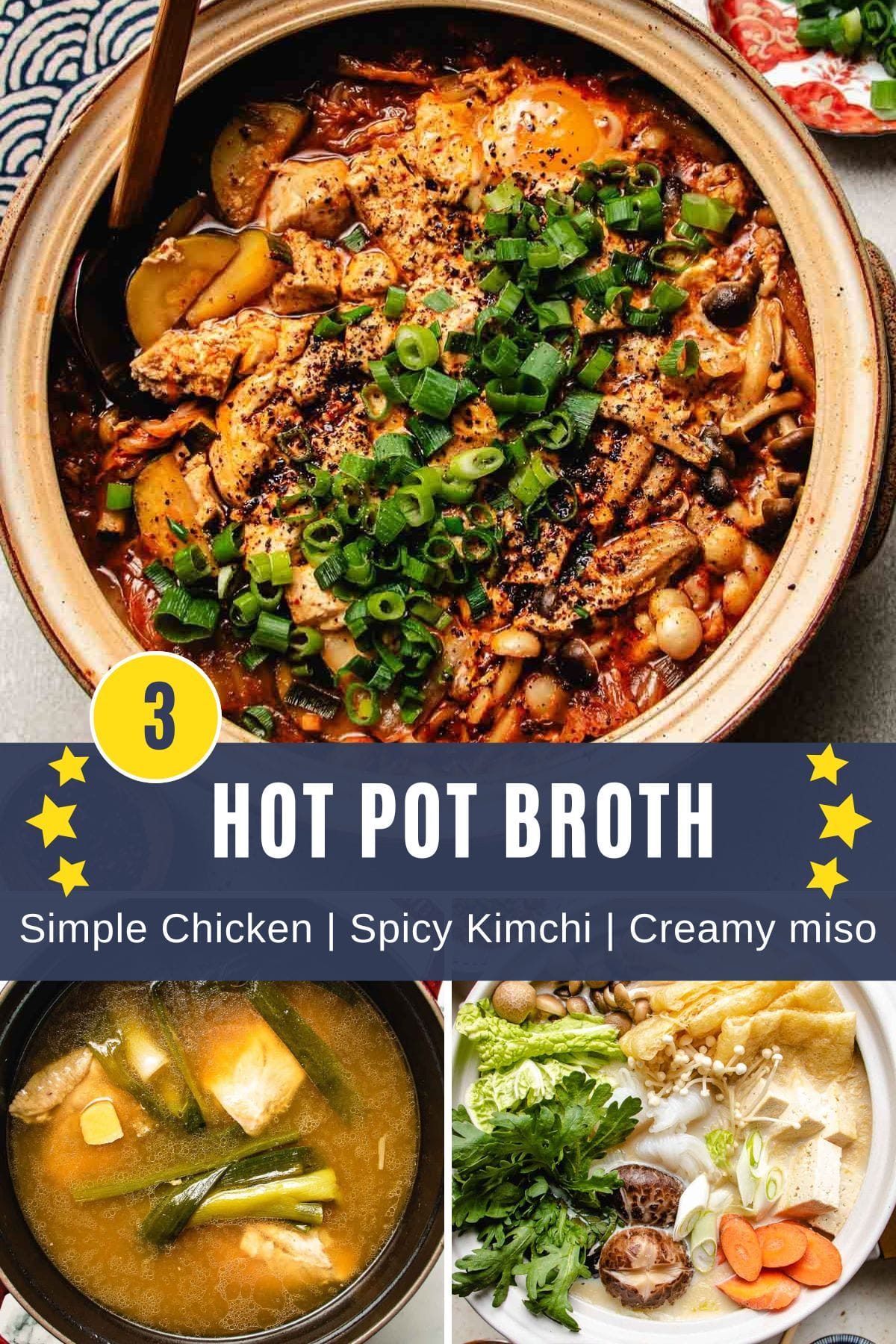
Table of Contents
What is hot pot broth
Hot pot broth is the heart and soul of a good hot pot meal. For many Asian families, broth is everything—it’s how we judge soups, noodle dishes, and of course, hot pot.
When you think about hot pot, there are five key parts: meat and seafood, vegetables, dipping sauces, add-ons, and the broth.
You dip the ingredients into the hot broth to simmer as you cook, eat, and chat with family and friends during the meal (similar to Western fondue). And let’s be honest, the broth is the most important. It’s the flavor base that brings everything together.
Hot pot soup bases come in all kinds of flavors—spicy or mild, clear or creamy. It really depends on the style or what you’re craving. Plus, it’s the only part that’s cooked ahead of time. Everything else, like the thinly sliced meats and veggies, gets cooked right there at the table in the bubbling hot broth.
Top 3 hot pot broths (spicy and non-spicy)
Let’s talk about hot pot soup base! In this section, I’ll walk you through three delicious and easy hot pot broths—something for everyone. Each one comes with a quick overview of the ingredients and easy steps to put it all together.
- Simple chicken broth (clear broth): a simple and classic clear chicken broth with ginger scallion aroma.
- Creamy soy miso broth (vegan): a creamy and milky (dairy-free) Japanese style hot pot soup base.
- Spicy kimchi broth: a bold, and little spicy kimchi broth that tastes zesty and deeply umami.
Tools (cookware):
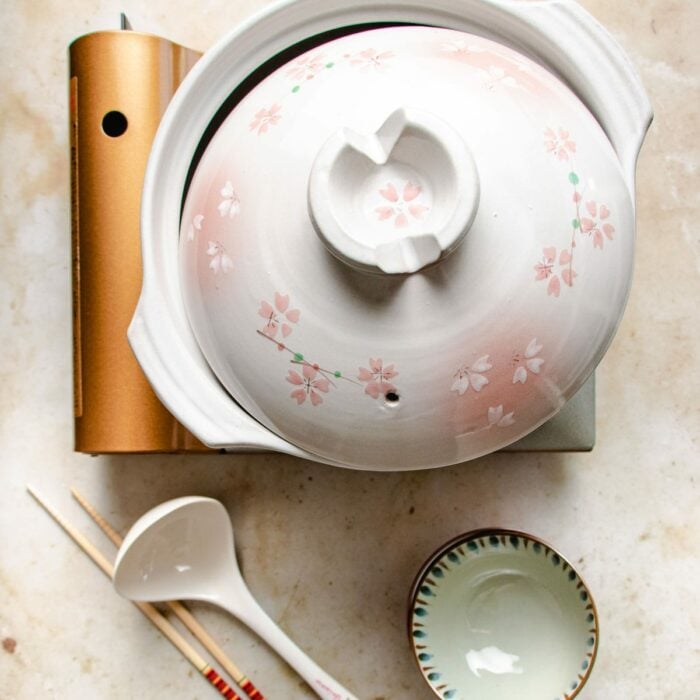
- You’ll need a 4-5 qt. Soup pot (e.g., Donabe, stainless steel hot pot, or Dutch oven)
- Chopsticks, soup ladle, strainer scoop, serving bowls
- Portable stove
1. Simple chicken broth
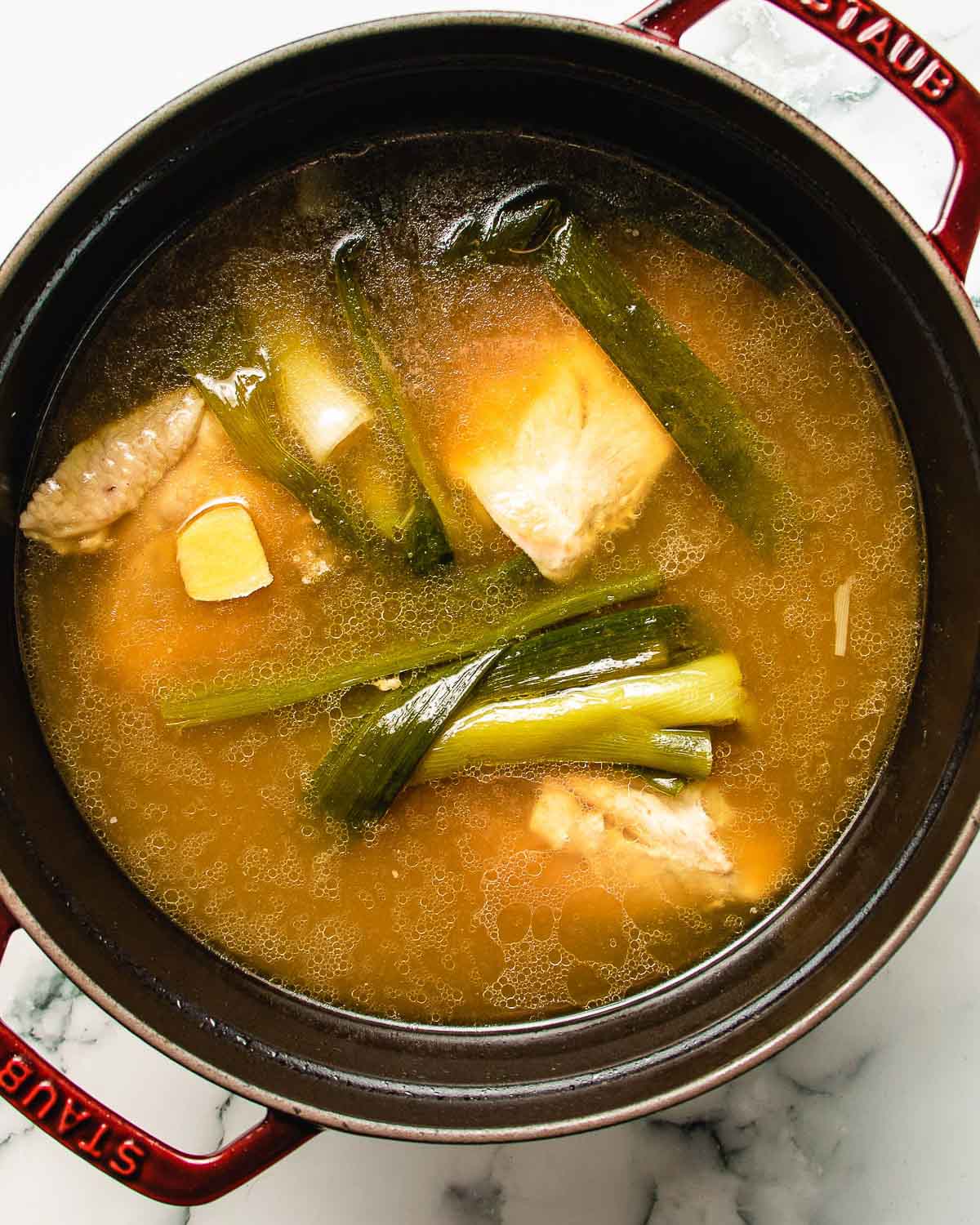
- Ingredients: Chicken stock, water, ginger, scallions, salt, shiitake mushroom seasoning (or homemade chicken bouillon).
- How to make it: Simmer chicken stock with water, scallions, and ginger for 15 minutes. Discard the aromatics, then season with salt and bouillon to taste.
- Tip: Use the same broth for Chicken hot pot, Wonton egg drop soup, or Shrimp wonton soup!
2. Creamy miso soy broth (vegan hot pot)
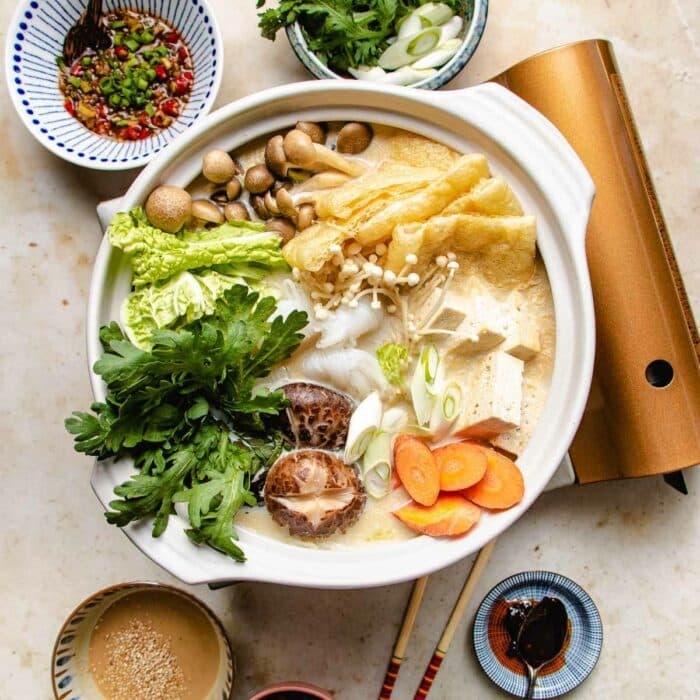
- Ingredients: Soy milk, water, dried kombu, white miso paste, shiitake mushroom seasoning.
- How to make it: Simmer soy milk, water, and kombu gently for 12-15 minutes. Add shiitake mushroom seasoning and dissolve miso paste into the broth. Leave the kombu in for added flavor and texture.
- Tip: Slow simmer over low heat so the milky broth doesn’t curdle.
3. Spicy kimchi broth
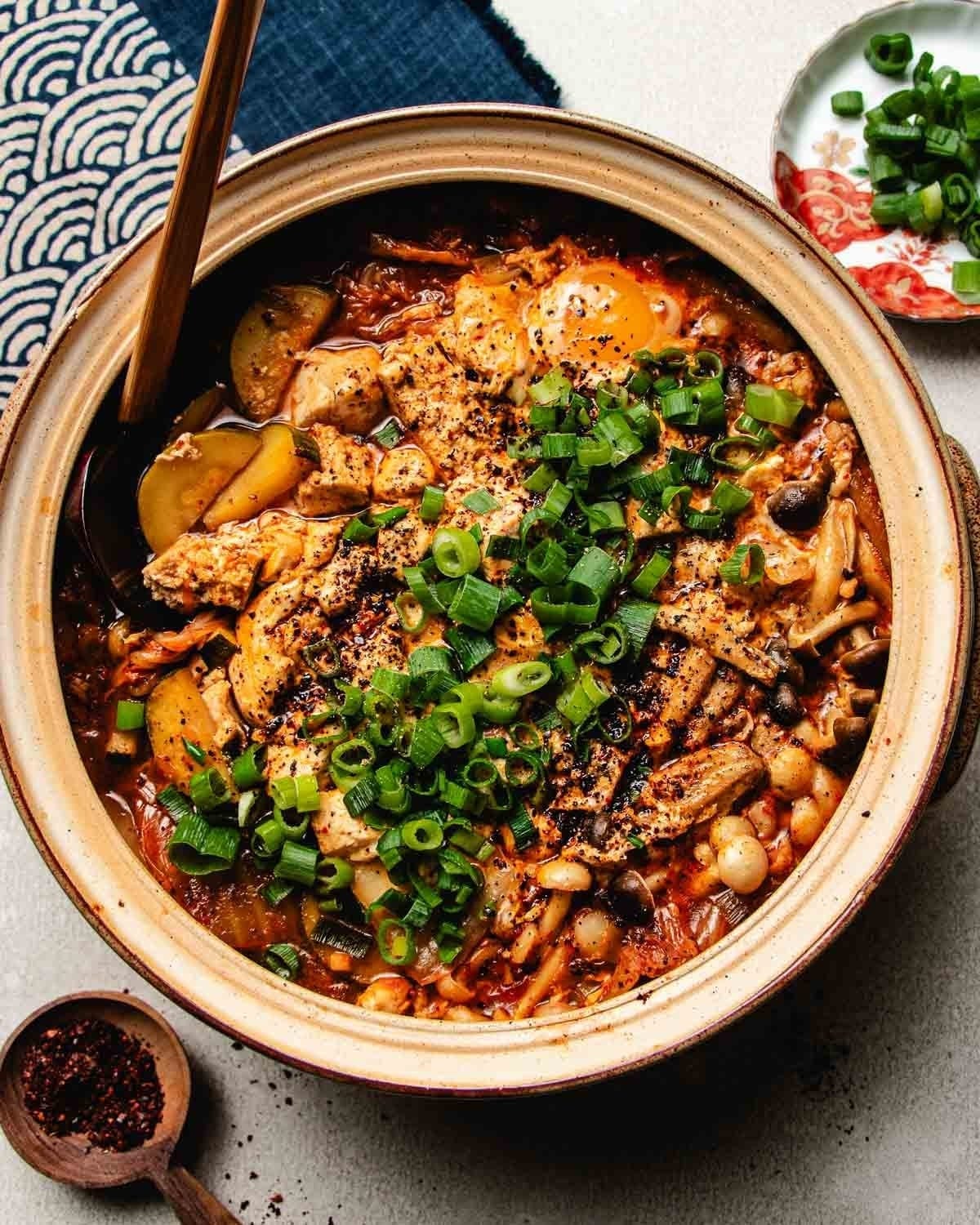
- Ingredients: Napa cabbage kimchi, scallions, avocado oil, gochugaru, chicken stock, kimchi juice, mirin, mushroom bouillon (or chicken bouillon).
- How to make it: Sauté scallion whites and gochugaru in oil until fragrant. Add drained kimchi and sauté briefly, then pour in stock and bring to a boil. Simmer until the kimchi softens, then stir in kimchi juice, mirin, and bouillon.
- Tip: Use the same broth to make Silken tofu kimchi soup!
Tip
Keep the Broth Level Just Right
Since all the ingredients will be added to the broth to cook, keep the broth about 70-75% full. Too little makes cooking uneven, and too much risks spills. As it reduces, top it off with more chicken broth or hot water to keep things running smoothly.
What can I put into the broth?
There’s no right or wrong answer when it comes to what goes into a hot pot. For proteins, choose thinly sliced cuts with a good balance of lean and fat so they cook quickly and stay tender. Keeping the meat slightly lean also helps the broth stay savory without getting greasy.
- Hot pot meat/seafood: Think thinly sliced beef, pork, lamb, or chicken. Seafood options like shrimp, scallops, fish fillets, and mussels are also great choices.
- Hot pot vegetables: Napa cabbage, baby bok choy, tong ho, AA choy, spinach, mushrooms (shiitake, enoki, or oyster), tofu, daikon radish, and lotus root work beautifully.
- Dipping sauces: Shacha sauce, Garlic chili sauce, and check out my 5 Hot Pot Sauces for inspiration.
- Extra add-ons: Dumplings, chicken wontons, Chinese noodles, tofu puffs, fish balls, or rice cakes are perfect for extra variety and texture.
Good to know
Hot pot cooking times
When cooking hot pot, start with the ingredients that take the longest, like carrots and daikon, and save the softer, quicker-cooking items for last, like silken tofu or tender leafy greens. Thinly sliced meats, like beef, only need a few seconds in the broth to stay tender and juicy.
What to do with leftover hot pot broth
Can you drink the leftover hot pot broth? Absolutely! After cooking all those delicious ingredients, the broth becomes the star of the meal—rich, flavorful, and impossible to skip. Save some room in your stomach just for the broth—you won’t regret it!
Pro tip: I love cracking an egg into the broth and letting it poach right in the pot. The egg yolk melts into the broth, creating the most luxurious, silky texture in your serving bowl. It’s probably one of my favorite elements of making hot pot at home!
❤️❤️❤️
ChihYu’s helpful notes
- Keep It Balanced: Keep the broth simple—not too rich, salty, or greasy—so it enhances the ingredients without overwhelming them.
- Make It Ahead: Prepare the broth first to save time and have the flavor base ready before starting the meal.
- Wait for a Boil: Always bring the broth to a boil before adding ingredients to ensure even cooking and better flavor extraction.
- Storing Leftovers: Let the broth cool completely, then store it in an airtight container in the fridge for up to 3 days or freeze it for later use.
- Repurpose the Broth: Use leftover broth as a soup base or simmer it with noodles, rice, or additional veggies for a quick, flavorful meal.
Hot pot broth recipes
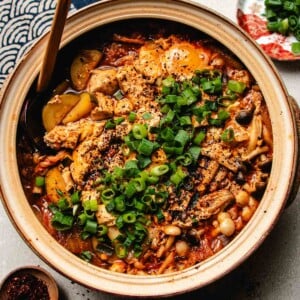
Ingredients
Simple chicken broth:
- 2 whole scallions
- 3 cup chicken stock I use Pacific foods
- 1 cup water or to taste
- 0.1 oz ginger slices 2 long, thin pieces
- Coarse salt to taste
- 1 tsp shiitake mushroom seasoning or chicken bouillon powder
Vegan miso soy broth:
- 2 cups soy milk unsweetened
- 3 cups water
- 3×3 inch dried kombu (kelp)
- 2 tsp Shiitake mushroom seasoning
- 2-3 tbsp white miso paste
Spicy kimchi broth:
- 3-4 whole scallion
- 14 oz Napa cabbage kimchi
- 1 tbsp avocado oil
- 2 tsp gochugaru (Korean red pepper flakes)
- 2-2.5 cup chicken stock I use Pacific foods
- 1 tbsp mirin
- 1 to 1.5 tsp Shiitake mushroom seasoning or chicken bouillon to taste
Equipment
- 1 4-5 quart soup pot Donabe, Stainless steel hot pot, or Dutch oven
- Chopsticks
- Soup ladle
- Portable stove optional
Instructions
Simple chicken broth:
- Lightly pound the white parts of the scallion with the back of a kitchen knife and place them in a 4-5 quart soup pot.
- Add chicken stock, water, and ginger slices. Cover and bring to a gentle boil over medium heat.
- Reduce heat to simmer for 15 minutes.
- Discard the scallions and ginger. Taste and adjust seasoning with salt and bouillon powder as needed.
Vegan miso soy broth:
- In a soup pot, combine soy milk, water, and kombu. Cover and simmer gently over low heat for 12-15 minutes.
- Tip: If your pot doesn’t have a venting hole, leave the lid slightly ajar to prevent the milk from boiling over.
- Add mushroom seasoning and dissolve miso paste into the broth. Stir well.
- Tip: Leave the kombu in the broth as it continues to simmer. The kombu will expand, soften, and become edible, adding good plant-based collagen to your broth.
Spicy kimchi broth:
- Chop scallions into rings, separating whites and greens.
- If using whole cabbage kimchi, transfer to a large bowl and cut into bite-sized pieces using kitchen shears. Drain excess kimchi juice into a bowl (reserve for later).
- Heat oil in a 4-5 quart soup pot over medium heat until warm.
- Add scallion whites and gochugaru, sautéing with a wooden spoon until fragrant (about 2-3 minutes).
- Add drained kimchi and continue sautéing for 2-3 minutes. Ensure a consistent sizzling sound; increase heat if needed.
- Pour in chicken stock and stir to prevent sticking. Cover and bring to a gentle boil over medium heat (5-6 minutes).
- Reduce heat to medium-low and simmer until kimchi softens but isn’t mushy (about 5-6 minutes). Stir occasionally.
- Add reserved kimchi juice, mirin, and bouillon powder. Taste and adjust seasoning as needed.
Notes
- Storage and Leftovers: Yes, you can enjoy the leftover hot pot broth! After simmering all those tasty ingredients, the broth becomes rich and flavorful. Store any leftovers in the refrigerator in an airtight container and enjoy it within 5 days. Reheat it for a second meal or sip it as a comforting treat.
- Pro Tip: Crack an egg into the broth while it’s still warm and let it poach. The silky egg yolk adds a luxurious texture, making it an irresistible addition to your bowl!
- Hot pot examples:
- Vegan hot pot (miso soy broth)
- Kimchi hot pot (coming soon)
Nutrition
Nutrition information is automatically calculated, so should only be used as an approximation.
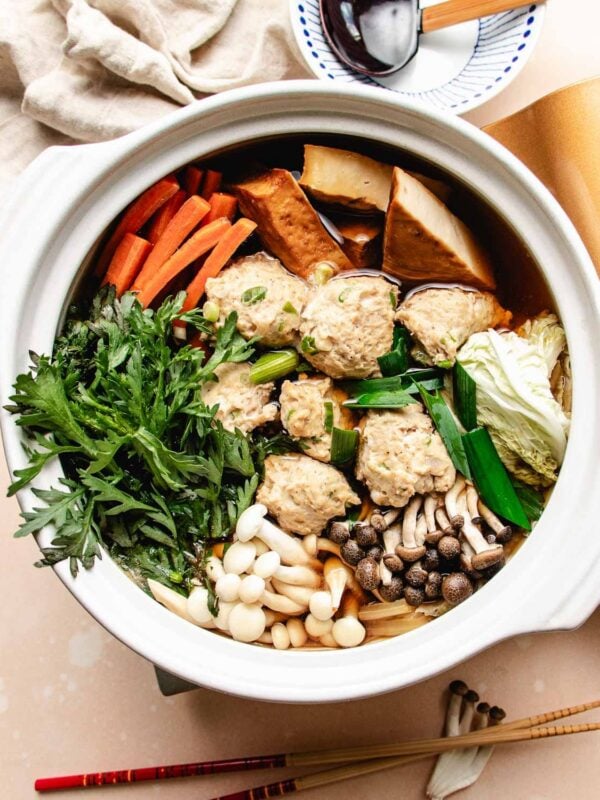
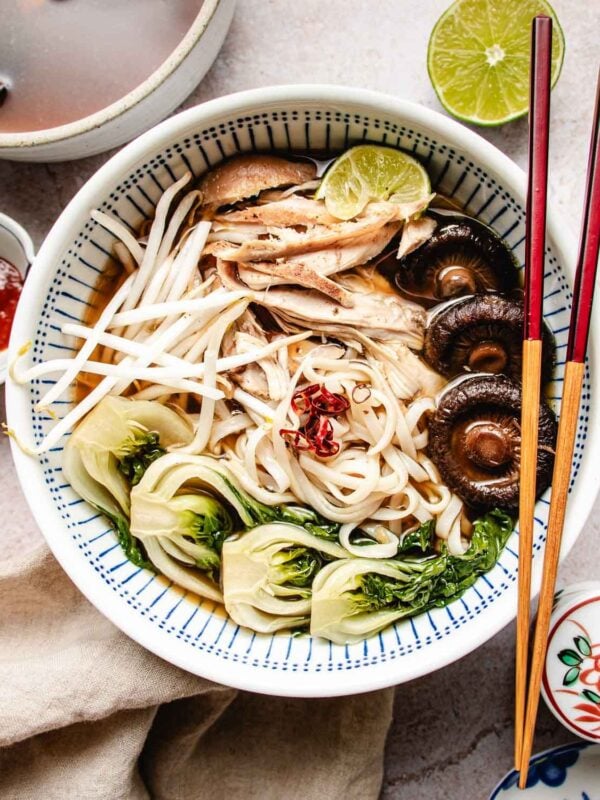











Love the simple chicken broth. So flavorful and easy to pair with our hotpot ingredients. A great broth. Next time we will the the spicy one!
Thank you so much!
We tried the spicy kimchi and the simple chicken broth for our hot pot gatherings with family and friends and everyone loved them! Simple to assemble and the flavor is excellent. Goes well with any hot pot toppings. Next time, we will try the miso ginger.
Thanks so much!